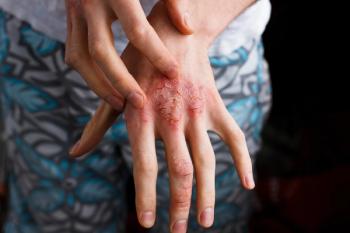
Patterns in atopic dermatitis consults
Dermatologists need to consider modifying the appointment system to improve access to care for patients with atopic dermatitis flares, says this expert.
Dermatologists need to consider modifying the appointment system to improve access to care for patients with atopic dermatitis flares, suggests researcher Jonathan Silverberg, of the Department of Dermatology, Preventive Medicine and Medical Social Sciences, at Feinberg School of Medicine, Northwestern University.
In a recent analysis of patient consults, published in Journal of the American Academy of Dermatology, Dr. Silverberg and colleagues found that outpatient healthcare visits in U.S. children and adults with atopic dermatitis or eczema were increasing over time. The greatest increase in consultation frequency for atopic dermatitis was seen with primary care providers where visits increased from 339,889 to 1,025,739 annually between 1996-1999 to 2012-2015. Meanwhile frequency of atopic dermatitis visits to dermatologists decreased from 446,669 annually to 371,003.
Notably, atopic dermatitis visits to primary care providers were more likely to be acute visits; whereas dermatology visits were more likely to be chronic visits and referrals.
“Adapting the appointment system to accommodate walk-in or urgent visits for flares would improve access for the flaring patient,” Dr. Silverberg told Dermatology Times.
Consult patterns
To learn more about the patterns and drivers of consultations for atopic dermatitis in the United States, the researchers at Northwestern University analyzed data from the 1993-2015 National Ambulatory Medical Care Survey.
The National Ambulatory Medical Care Survey is a cross-sectional, national survey implemented by the National Center for Health Statistics via the Centers for Disease Control to sample outpatient physician visits to estimate utilization of ambulatory services where physicians participating are asked to provide data on approximately 30 patient visits during a one-week period. The conditions presented by the patient are coded along with visit duration, whether the patient had been referred, the number of visits in the past 12 months and the major reason for the visit, such as was it an acute flare up or routine visit for chronic problem.
The researchers collected and pooled data on a total of 128,300 pediatric and 623,935 adult visits, into either two or four-year spreads to minimize variance; then, constructed multivariable logistic regression models to determine the predictors of atopic dermatitis visits to primary care providers, dermatologists or allergists.
Overall, the analysis shows a high frequency of outpatient healthcare utilization in U.S. children and adults with atopic dermatitis or eczema, and that frequency of visits has increased over time, from 867,649 annually in 1996-1999 to 1,950,546 annually in 2012-2015.
Visits for atopic dermatitis were most common among children aged 0-4 years (32.0%) and 5-9 (10.6%), decreased in adolescents aged 10-19 years (11.6%), remained fairly steady between ages 20-89 years (1.0%-4.7% for each ten year range), and then increased at age >90 years (20.7%).
Among specialist providers, the study showed that pediatricians saw most children with atopic dermatitis, and dermatologists saw most adults. Adults with comorbid allergic rhinitis or food allergies were more likely to see an allergist than a dermatologist.
“This likely reflects a referral bias, such that patients with atopic multi-morbidity are more likely to be seen by allergists. Further, dermatologists may not address atopic comorbidities during atopic dermatitis visits as it is outside their practice scope,” the authors reported.
Atopic dermatitis is very common in the United States, affecting approximately 13% of children and 7% of adults; and as a result, there will never be enough dermatologists to see all these patients, Dr. Silverberg said.
“Many if not most patients with mild and intermittent atopic dermatitis can be managed in the primary care setting. Patients experiencing a flare will probably have an easier time getting into their primary care provider during a flare. Most primary care providers can provide basic skincare recommendations and short-term treatment approaches for flares,” he said. “However, patients with chronic atopic dermatitis, moderate to severe atopic dermatitis, refractory atopic dermatitis, and atopic dermatitis complicated by comorbid infections or contact dermatitis require customized treatment approaches that are best suited for the dermatology setting.”
Many flaring patients will have chronic disease and it is important to assess the chronicity and longitudinal course of atopic dermatitis to properly tailor treatment, and that this is often best done in dermatology, Dr. Silverberg stressed.
“Atopic dermatitis patients are typically given a prescription for an undersized tube of topical corticosteroids and told to use it for a few weeks,” Dr. Silverberg said. “Patients with chronic atopic dermatitis require long-term treatment approaches, such as steroid-sparing agents and use of proactive therapy for flare prevention.”
References:
Singh P, Silverberg JI.Outpatient utilization patterns for atopic dermatitis in the United States. J Am Acad Dermatol. 2019 Mar 15. pii: S0190-9622(19)30435-9. doi: 10.1016/j.jaad.2019.03.021. [Epub ahead of print]
Newsletter
Like what you’re reading? Subscribe to Dermatology Times for weekly updates on therapies, innovations, and real-world practice tips.


















